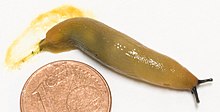| Ariunculus | |
|---|---|

| |
| A live individual of Ariunculus speziae, coin diameter is 16.25 mm | |
| Scientific classification | |
| Domain: | Eukaryota |
| Kingdom: | Animalia |
| Phylum: | Mollusca |
| Class: | Gastropoda |
| Order: | Stylommatophora |
| Family: | Arionidae |
| Genus: | Ariunculus Lessona, 1881 |
| Type species | |
| Ariunculus speziae Lessona, 1881 | |
| Diversity | |
| 2 species, each in its own subgenus | |
Ariunculus is a genus of air-breathing land slugs in the family Arionidae, the roundback slugs. Sometimes it has been considered as a subgenus of Arion, and sometimes the subgenus Ichnusarion has been raised to generic rank.
Etymology
The stem of Arion plus the suffix -unculus, which is a diminutive in Latin. Hence "little Arion". Pollonera justifies why "Ariunculus" is appropriate rather than "Arionculus" (cf. "homo" and "homunculus").
The subgenus name Ichnusarion is also based on "Arion", to which has been added "Ichnusa", a Latin name of Sardinia, where the single species of this subgenus is endemic.
Species
Only two species are currently recognised:
subgenus Ariuncululus
- Ariunculus speziae Lessona, 1881 – type species of the genus; Italian Alps with one record in Switzerland
subgenus Ichnusarion Pollonera, 1890
- Ariunculus isselii Lessona & Pollonera, 1882 – Sardinia
Other species have been discounted as distinct members of the genus:
- A. mortilleti and A. camerani are considered synonyms of A. speziae (all three were originally described in the same article, but differ only in size and coloration, not genitalia);
- A. moreleti is considered a species of Letourneuxia;
- A. pallaryi matches Letourneuxia numidica in its description;
- A. austriacus has been synonymised with Arion subfuscus;
- A. tricolor and A. nigratus are thought to have been misidentified juveniles of a large Arion;
- A. ischii was apparently a misprint for A. isselii.
Diagnostic characters
Genital characters that have been proposed as diagnostic of the genus are:
- the genital pore is very anterior, anterior to the pneumostome;
- the atrium is large;
- the duct of the bursa copulatrix opens near the end of the epiphallus;
- the oviduct is long with two bends;
- the epiphallus blends imperceptibly with the vas deferens;
At least in one species of Ariunculus, this last character reflects that sperm is transferred naked rather than in a spermatophore formed in the epiphallus; this is a fundamental contrast with Arion and Geomalacus.
Ariunculus differs from Geomalacus, and is similar to Arion, in that the caudal gland is prominent and the mantle contains only calcareous granules rather than a shell plate.
References
- ^ Lessona, M. (1881). "Sugli Arion del Piemonte". Atti della Reale Accademia delle Scienze di Torino. 16: 185–197 + 1 plate.
- Heynemann, D.F. (1905). "Die geographische Verbreitung der Nacktschnecken". Abhandlungen der Senckenbergischen Naturforschenden Gesellschaft. 30: 1–92 + 2 plates. doi:10.5962/bhl.title.46556.
- Ehrmann, P. (1956). "Vol. 2.(1). Kreis: Weichtiere, Mollusca". In Brohmer P.; Ehrmann P.; Ulmer G. (eds.). Die Tierwelt Mitteleuropas. Leipzig: Quelle & Meyer. pp. 1–264 + plates 1–13.
- Welter-Schultes, F.W. (2012). European non-marine molluscs, a guide for species identification. Göttingen: Planet Poster Editions. ISBN 978-3-933922-75-5.
- Schileyko, A.A. "Treatise on Recent terrestrial pulmonate molluscs. Part 15: Oopeltidae, Anadenidae, Arionidae, Philomycidae, Succineidae, Athoracophoridae". Ruthenica. Suppl. 2: 2049–2210.
- ^ Pollonera, C. (1890). "Recensement des Arionidae de la Région Paléarctique". Bollettino dei Musei di Zoologia ed Anatomia Comparata della Reale Università di Torino. 5 (87): 1–42.
- ^ Hutchinson, J.M.C.; Reise, H. (2015). "Mating in Ariunculus isselii, an arionid slug without a spermatophore". Journal of Molluscan Studies. 81 (2): 247–258. doi:10.1093/mollus/eyu086.
- ^ Bishop, M.J. (1976). "I molluschi terrestri della provincia di Novara". Atti della Società Italiana di Scienze Naturali e del Museo Civico di Storia Naturale di Milano. 117: 265–299.
- Rüetschi, J.; Stucki, P.; Müller, P.; Vicentini, H.; Claude, F. (2012). Rote Liste Weichtiere (Schnecken und Muscheln). Gefährdete Arten der Schweiz, Stand 2010. Neuenburg: Bundesamt für Umwelt, Bern, and Schweizer Zentrum für die Kartografie der Fauna.
- ^ Lessona, M.; Pollonera C. (1882). Monografia dei limacidi italiani. Turin: Ermanno Loescher. doi:10.5962/bhl.title.10743.
- ^ Castillejo, J.; Rodríguez, T. (1991). Babosas de la Península Ibérica y Baleares: inventario crítico, citas y mapas de distributión (Gastropoda, Pulmonata, Terrestria nuda). Monografías da Universidade de Santiago de Compostela no. 162 (PDF). Santiago de Compostela: Universidade de Santiago de Compostela, Servicio de Publicacións e Intercambio Científico.
- Reischütz, P.L. (1980). "Ariunculus austriacus Babor synonym zu Arion (Mesarion) subfuscus (Drapanaud)". Mitteilungen der zoologischen Gesellschaft Braunau. 3: 297–298.
- Germain, L. (1930). Faune de France, Vol. 21: Mollusques terrestres et fluviatiles. Part 1 (PDF). Paris: Lechavalier.
- Platts, E.A.; Speight, M.C.D. (1988). "The taxonomy and distribution of the Kerry slug Geomalacus maculosus Allman, 1843 (Mollusca: Arionidae) with a discussion of its status as a threatened species". Irish Naturalists' Journal. 22 (10): 417–430. JSTOR 25539243.
| Taxon identifiers | |
|---|---|
| Ariunculus | |